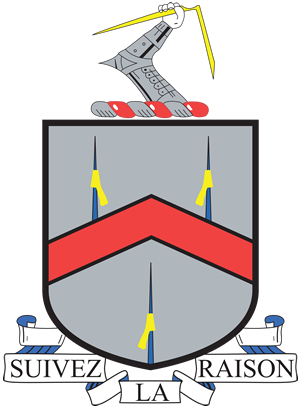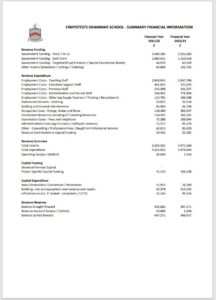The Governing Board of Ermysted’s Grammar School has decided to publish material about the School’s financial position in its desire to ensure openness, transparency and best practice concerning all information about the School.
As a Local Authority maintained school, Ermysted’s financial information is recorded and reported via North Yorkshire County Council to the Department for Education (“DfE”) using a standardised approach which allows for the consolidation of records under terminology and headings which are not necessarily clear to non-expert readers.
Therefore, the School has simplified the information into a format which the Governors believe is more accessible.
The information has been validated by the Local Authority following the end of each financial year and separately the School has also engaged the services of an independent professional firm to audit the records and confirm their accuracy.
Please click here to visit the school’s page on the schools financial benchmarking service.
Notes to the accounts
Revenue account
The School receives income from the DfE via the Local Authority for pupils aged from 11 to 16. The amount is based on the number of pupils and a fixed amount per pupil, but further subject to some minor adjustments to the total.
The School receives funding for students in the Sixth Form based on a different methodology, but again essentially determined on the basis of the number of students in Year 12 and Year 13.
The third stream of Government funding is provided to support particular groups, specifically those who qualify for Pupil Premium or who have additional educational needs. The amount of money from this stream can vary quite significantly from year-to-year depending on the actual cohort of pupils at the School. This money is ring-fenced to be used in support of those pupils and a separate explanation of how that money has been spent is provided each year on the School’s website.
Capital account
Ermysted’s position is complicated slightly by the fact that it is a Voluntary-Aided Foundation School. As a consequence the Governors (the School) are usually required to contribute 10% of the Capital Funding allocated from the School’s revenue budget or from its reserves.
This Voluntary-Aided status has also meant that for many years, such money has been transferred by DfE to the Foundation and drawn down by the School as and when required largely to support maintenance and repairs.
The summary information provided distinguishes between the annual allowance provided for maintenance and repairs and project specific funding awarded for particular projects as a result of bids submitted to the DfE and the Local Authority.
Where some Capital Funding has been awarded or allocated to particular projects it has not always been transferred from the Foundation to the School at the same time as the project has been completed because the DfE may only provide the money several weeks after the completion of a project.
This can affect the numbers shown in the accounts and has been the case in each of the last four years where projects have been completed (and expenditure incurred by the School) in one financial year but the associated income not transferred from the Foundation to the School until the following period. For that reason there is a difference between figures shown for Capital Funding and Capital Expenditure.
Financial reserves
The School has recovered from a challenging financial position a few years ago which had forecast a cumulative deficit and has accumulated money in its reserves in the last few years through careful control of costs and prudent financial management, for example operating with a smaller Senior Leadership Team than other comparable schools and renegotiating external contracts.
The Governing Board believes that it is prudent to maintain a level of financial reserves in the order of £300,000 to £400,000 against the need for unforeseen capital expenditure or to contribute towards significant future investment.
Performance in 2021/22 and 2022/23
The School benefitted from an increase in funding per pupil in 2022/23 which boosted overall income, additionally income from lettings was back to pre-pandemic levels. Offsetting this were staff salary increases and the impact of energy prices which have increased by over 360%.
A prudent level of financial reserves has continued to be maintained during the course of 21/22 and 22/23. Significant capital funding has been secured which has allowed the School to continue investing in works on-site without having to impact heavily on these reserves. Projects have focused on site security, energy saving projects and ICT infractructure, works such as perimeter fencing, a programme of lighting upgrades to LED, roof repairs and building maintenance, replacement windows and doors in the English/DT block, upgrading the computers in the Sixth Form library and a new telephone system.
Overall, this left a broadly flat financial outturn for the year.
School employees with a gross annual salary of £100,000 or more
| Salary | Number of employees |
| £100,000 – £110,000 | 1 |

